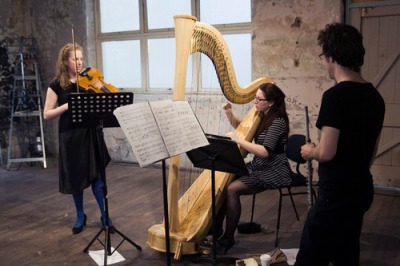
Petrichor Trio
Conduit Arts
Rowan Hamwood (flute)
Alexina Hawkins (viola)
Jessica Fotinos (harp)
Wednesday 22 May
Petrichor’s recent concert at Conduit Arts found young and established composers alike asking themselves what on earth to do with a harp. Petrichor’s “take no prisoners” style of performance charged the small space of Conduit Arts with an atmosphere of absolute concentration.
Julius Millar’s Two Pieces for Flute, Viola and Harp contrasted a soundscape haunted with apparitions of clusters and string tremoli with a rhythmic piece based around a “ticking” harp ostinato. Sometimes the viola would join the harp in a hocket figure, or soar away on a legato line. Well-developed counterpoint between the flute and viola provided a moment of intense interest that then exploded into a spectacular cacophony on all three instruments.
Barry Conyngham’s Streams cast the harp in a similar role, as the pulsing accompaniment to contrapuntal play between the harp and viola. Conyngham transitions fluidly between such textures and layered trills with swelling dynamics and glorious open chords cut short by the idiomatic harpistic string-clang, which has to be heard to be believed (and if you go to harp concerts, will be believed more often than you wish).
Evan Lawson’s Skinnis for Flute, Viola and Harp (now on its second outing) was the only piece to utilise the harp’s majestic glissandi and full, ringing chords. These kitschy effects were welcome after the crystal-clear articulation and motoric effects of the “bean-counting harp.”
Sofia Gubaidulina’s The Garden of Joy and Sorrow canvassed all of these possibilities for combining flute, viola and harp, then developed many more through a series of vignettes punctuated by spoken German phrases. A particularly fascinating sound was an extremely fast phrase on viola, played with a very fast bow to produce a “squeaky” sound like a tape on fast-forward, above a machine-gun tattoo on the harp with paper woven between the strings.
The program also included a series of solo works including Gordon Kerry’s Antiphon for viola, Salvatore Sciarrino’s Canzona di Ringraziamento for flute and Suart Greenbaum’s Church at Domburg for harp. In all three cases the skill and conviction of these ANAM-trained musicians was in evidence.